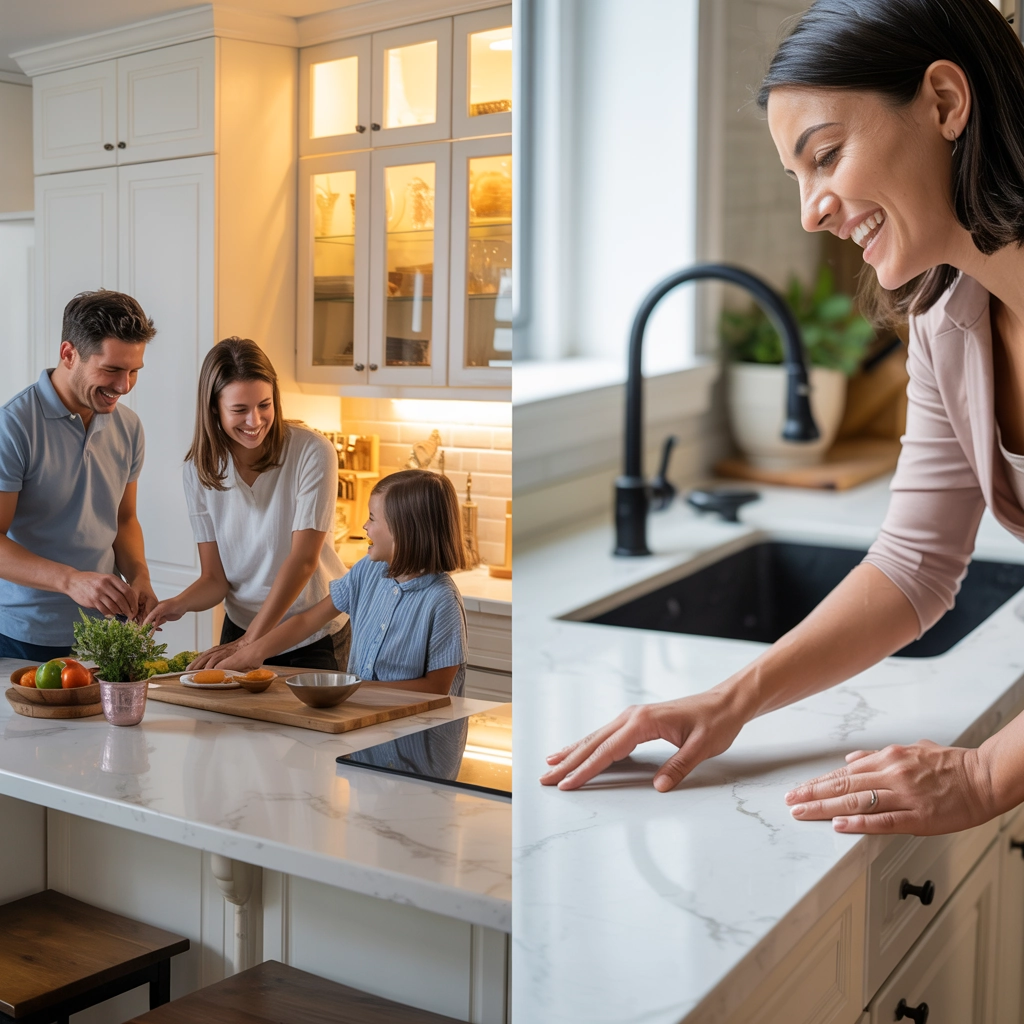"Just the Facts Ma'am"
Jul 14, 2025
Beyond the Facts: Tapping into Feelings During the Discovery Phase in Home Improvement Sales
“Just the facts, ma’am.”
If you recognize that phrase, congratulations — you’re probably over 40… and possibly grew up watching reruns of Dragnet, or had a parent who did. While Sergeant Joe Friday never actually said those exact words (TV myth alert!), his no-nonsense, fact-focused approach to police work became legendary.
And let’s be honest — it also sounds a lot like how many salespeople approach discovery conversations in home improvement.
Square footage? Check. Budget? Got it. Timeline? Documented.
But here’s what’s missing: feelings.
Now, I get it — bringing up emotions in a sales call might sound a little touchy-feely or “off-script.” But here’s the truth: when homeowners invest thousands into renovations, they’re not just buying materials. They’re buying transformation — and more specifically, the way that transformation makes them feel.
Let’s talk about why “just the facts” doesn’t cut it in B2C home improvement sales — and how tapping into emotional drivers during discovery can radically improve your close rate, customer satisfaction, and referrals
Recently, while training a group of home improvement sales professionals, I noticed something fascinating during their practice discovery interviews. Almost every salesperson focused exclusively on gathering facts: square footage, budget numbers, timeline dates, and product specifications.
But something critical was missing.
When homeowners invest thousands in renovations, they're not just buying new windows or kitchen cabinets. They're purchasing the feelings these improvements will create: pride when hosting dinner parties, relief from maintenance worries, or the comfort of energy efficiency during harsh winters.
Yet in our role-play scenarios, not one salesperson asked, "How do you want your new space to feel?"
This disconnect highlights a common challenge in home improvement sales: we become so fixated on gathering technical requirements that we miss the emotional drivers behind major purchasing decisions.
The Emotional Reality of Home Improvement Purchases
Home improvement decisions are deeply personal. A kitchen renovation isn't just about countertop materials—it's about creating a space where families can connect over meals. New windows aren't merely about U-factor ratings—they represent protection, comfort, and pride of ownership.
Research consistently shows that 90% of consumer purchasing decisions are influenced by emotional factors, with logical reasoning serving primarily to justify what our emotions have already decided. Home improvement purchases, which directly impact our most intimate spaces, are even more emotionally charged.
Consider these emotional drivers behind common home projects:
- Kitchen renovations: Connection, entertainment confidence, family togetherness
- Bathroom upgrades: Personal sanctuary, morning routine enjoyment, relaxation
- Window replacements: Safety, comfort, reduced worry about energy bills
- Flooring projects: Pride in appearance, ease of maintenance, allergy relief
- Exterior improvements: Neighborhood status, arrival experience, first impression confidence
When your discovery focuses exclusively on specifications and budgets, you miss these powerful motivators—and the opportunity to position your solution as the emotional fulfillment your client seeks.

Why Sales Pros Default to Facts (And Why It's Limiting Your Close Rate)
Facts feel safe. They're concrete, measurable, and comfortable to discuss. Asking about square footage doesn't feel intrusive; inquiring about someone's feelings might.
This fact-focus provides a false sense of professionalism. Many salespeople believe that sticking to technical specifications makes them appear more knowledgeable and less "salesy." The irony? This approach actually diminishes your ability to provide truly customized solutions.
Without understanding emotional motivations, you're forced to:
- Compete primarily on price (since you haven't established emotional value)
- Offer generic solutions (rather than addressing specific emotional needs)
- Handle unnecessary objections (that wouldn't arise if emotional buy-in existed)
The result? Lower close rates, smaller average sales, and more price sensitivity.
The Feeling-Fact Balance: A Better Approach to Discovery
The most effective home improvement discovery process balances both feelings and facts, with feelings taking precedence. Why? Because emotional needs determine which facts actually matter to your customer.
For example, if safety concerns drive a window replacement, energy efficiency data becomes more meaningful than aesthetic options. If entertaining drives a kitchen renovation, flow and gathering space details outweigh storage specifications.
Here's how to structure your discovery for the optimal feeling-fact balance:
Stage 1: Emotional Exploration (Start Here)
Begin with questions that uncover how homeowners want to experience their improved space:
- "What would your ideal morning routine look like in your new bathroom?"
- "When you picture entertaining in your renovated kitchen, what do you imagine feeling?"
- "What aspects of your current windows cause you the most frustration day-to-day?"
- "How would you like to feel when you pull into your driveway after the exterior is complete?"
These questions reveal the emotional drivers that no specification sheet will ever capture. They also build rapport by showing you care about the client's lived experience, not just their project parameters.
Stage 2: Problem Amplification
Once you've identified emotional drivers, help customers articulate the full impact of their current situation:
- "How has that drafty living room affected your comfort during winter gatherings?"
- "What's it like trying to prepare holiday meals in your current kitchen layout?"
- "How does the water stain on the ceiling make you feel when guests visit?"
This stage creates emotional contrast between their current reality and desired outcome, establishing the true value of your solution beyond materials and labor costs.

Stage 3: Factual Collection (Only Now)
With emotional context established, you can now gather technical specifications with purpose:
- "You mentioned creating a more social cooking experience—how many people typically gather while you're preparing meals?"
- "Since energy efficiency is important for your comfort, what temperatures do you typically maintain throughout the seasons?"
- "Understanding that low maintenance is a priority for your busy lifestyle, what specific maintenance tasks cause you the most frustration currently?"
Now your fact-gathering has context and purpose. You're not just collecting measurements—you're assembling the technical requirements to deliver the emotional transformation your client wants.
Emotion-First Question Framework for Home Improvement Discovery
Notice how the emotion-first questions still lead to factual information, but through the lens of why those facts matter to the homeowner.
Recognizing Emotional Buying Signals
During discovery, customers offer emotional buying signals that many salespeople miss. Train yourself to notice and respond to:
Emotional Language: When customers use feeling words ("I hate," "I love," "I worry about"), they're revealing core motivations.
Future-Oriented Statements: "I can picture..." or "I imagine that..." indicate emotional investment in the outcome.
Personal Stories: Anecdotes about family gatherings, daily routines, or past experiences provide emotional context for their decision.
Non-Verbal Cues: Excitement, hesitation, or relief expressed through tone, posture, or facial expressions often signal emotional priorities more clearly than words.
When you detect these signals, dig deeper with follow-up questions: "Tell me more about that feeling" or "Why is that particularly important to you?"
Implementing Emotion-First Discovery in Your Sales Process
For sales managers and individual professionals looking to shift toward emotion-based discovery, consider these implementation steps:
- Develop emotion-focused question libraries specific to each product category (windows, kitchens, bathrooms, etc.)
- Create role-play scenarios that require salespeople to identify and address emotional drivers before discussing specifications
- Review sales notes for emotional language and coach teams to document emotional motivators alongside technical requirements
- Revise proposal templates to include sections that connect technical solutions to specific emotional benefits
- Train active listening skills that help sales professionals detect and explore emotional cues during discovery
Measuring the Impact of Feeling-Focused Discovery
After implementing emotion-first discovery techniques, track these metrics to measure impact:
- Average sale value (emotion-based selling typically increases project scope)
- Close rate (emotional connection reduces shopping around)
- Price objection frequency (emotional value diminishes price sensitivity)
- Referral rate (customers who feel understood become advocates)
- Implementation satisfaction (clearer emotional goals lead to higher satisfaction)
Beyond Discovery: Carrying Emotions Through the Sales Process
The emotional insights gained during discovery should inform every subsequent step in your sales process:
- Solution presentations should begin with the emotional transformation, not product specifications
- Objection handling should reconnect to emotional priorities when resistance arises
- Proposals should explicitly link features to the feelings they'll create
- Follow-up should reference emotional drivers identified during discovery
The Competitive Advantage of Emotional Intelligence
In today's home improvement market, where products and services increasingly commoditize, emotional intelligence during discovery creates significant competitive advantage. When homeowners feel truly understood—not just measured and quoted—they're less likely to comparison shop and more likely to value your expertise.
As one homeowner told me after working with an emotion-focused contractor: "Others gave us lower prices, but they were selling windows. This company was selling the peace of mind and comfort we actually wanted."
Remember, homeowners aren't buying products—they're buying better experiences in the spaces they care about most. When your discovery process reflects this reality, you'll connect more deeply, sell more effectively, and create customers who become enthusiastic advocates for your business.
For more strategies on building value beyond price in your sales process, schedule a Discovery call with Patrick.
If you'd like to talk to Patrick about how he could help you or your organization, schedule a 30 minute discovery call here.
Stay connected with news and updates!
Join our mailing list to receive the latest news and updates from our team.
Don't worry, your information will not be shared.
We hate SPAM. We will never sell your information, for any reason.

